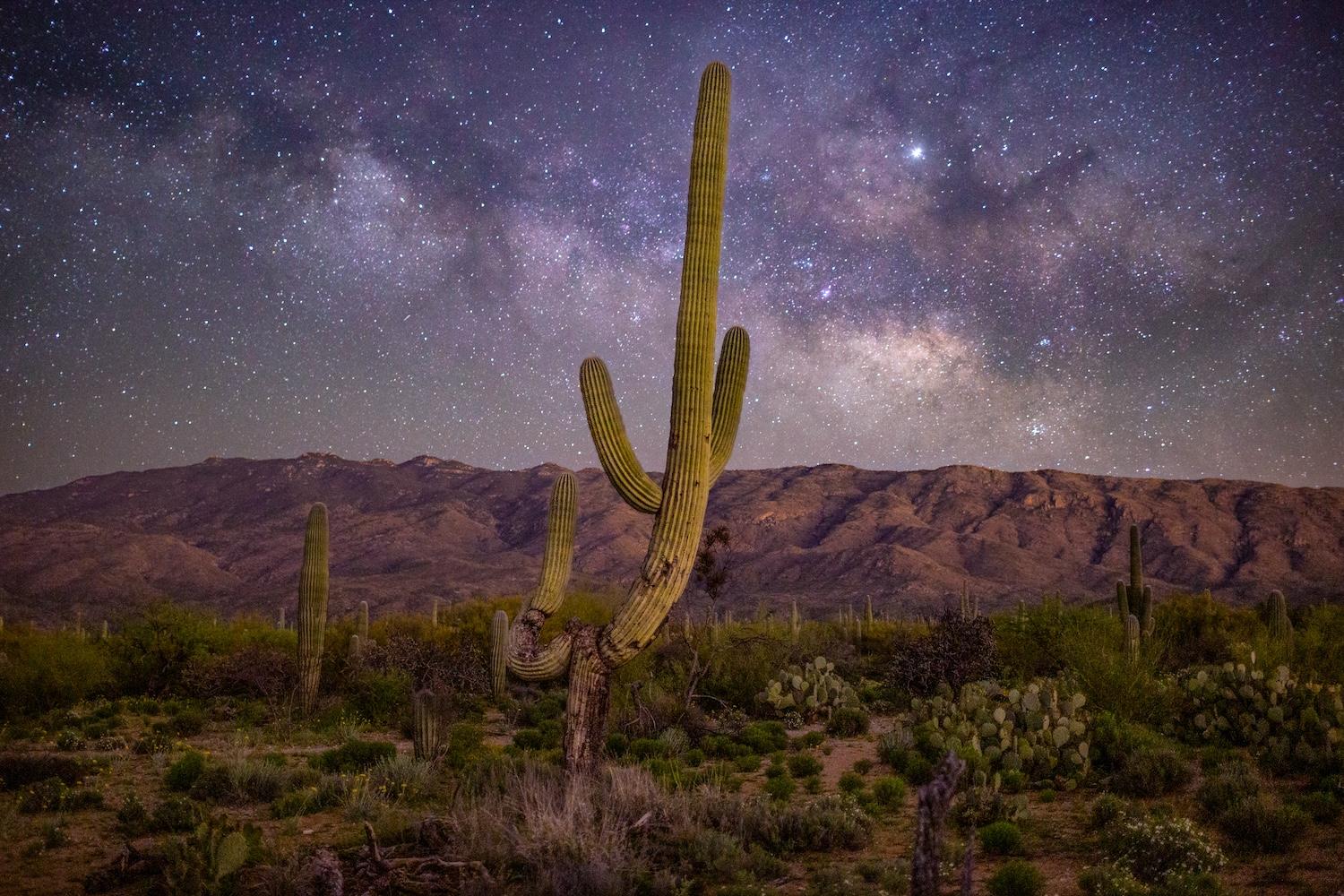
The night sky dazzles in Saguaro National Park in Tucson, Arizona. It has been certified as an Urban Night Sky Place/Ray Cleveland, Visit Tucson
As the sun set over the Sonoran Desert, the animals came out to play. The deer grazing among the saguaro were probably mule but could have been white-tailed — it was tough to say at dusk with only mini red-light flashlights in hand instead of binoculars. The bird that perched on a tree branch for a few seconds before flying away had the distinctive silhouette of an owl. There was no mistaking the yips and howls of coyotes.
Nineteen of us spent Valentine’s Day strolling along Cactus Forest Drive, a paved driving loop in Saguaro National Park, talking about cacti, bats, mountain lions, scorpions and javelinas. Malana Starr, part of the Next Generation Ranger Corps, started the “Explore the Night” walk at 6 p.m. by asking us to do a slow 360-degree turn and really absorb our surroundings. Roughly two hours later, she ended the walk with the same request.
It was much darker, of course. A first quarter moon shone in the cloudless sky without blocking out too many stars. In one direction, we could make out the Rincon Mountains. In the other, Tucson, population 545,000 or 1 million if you include the metro area.
The Arizona park offers night hikes “to create experiences for people to come out of their comfort zone,” Starr confided, acknowledging that some people fear the desert is “hostile” after sunset. “But also, we do it to create a space for people to come out and reconnect with darkness and the dark skies above.”
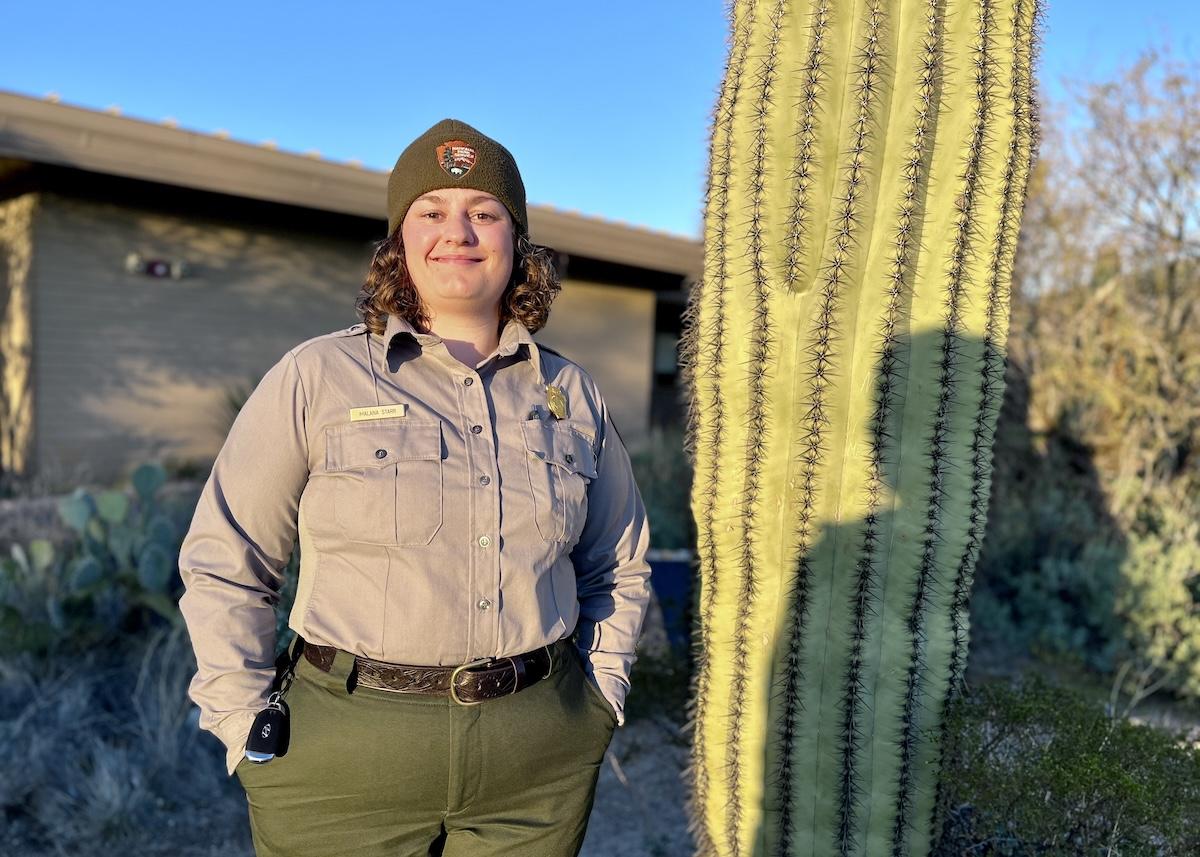
At Saguaro National Park's east district, Next Generation Ranger Malana Starr prepares to lead an "Explore the Night" walk down Cactus Forest Drive/Jennifer Bain
Now there is even more to celebrate after the sun goes down. In November, DarkSky International certified Saguaro (pronounced sah-WAH-row) as an Urban Night Sky Place — making it only the ninth place in the world and the second in the national park system to get this particular honor.
“Our designation means we’ve got some pretty darn good night skies that you don’t have to go too far outside of an urban area to get,” Starr enthused. “We put a lot of years into getting that designation and so now we’re more than happy to chat about it all the time.”
Named for the iconic symbol of the American Southwest, Saguaro National Park protects more than 94,000 acres of Sonoran Desert habitat, including rugged desert terrain, two mountain ranges and two million saguaros. Two separate units — the Rincon Mountain District in the east and the Tucson Mountain District in the west — flank Tucson. Each has a large undeveloped area as a buffer zone.
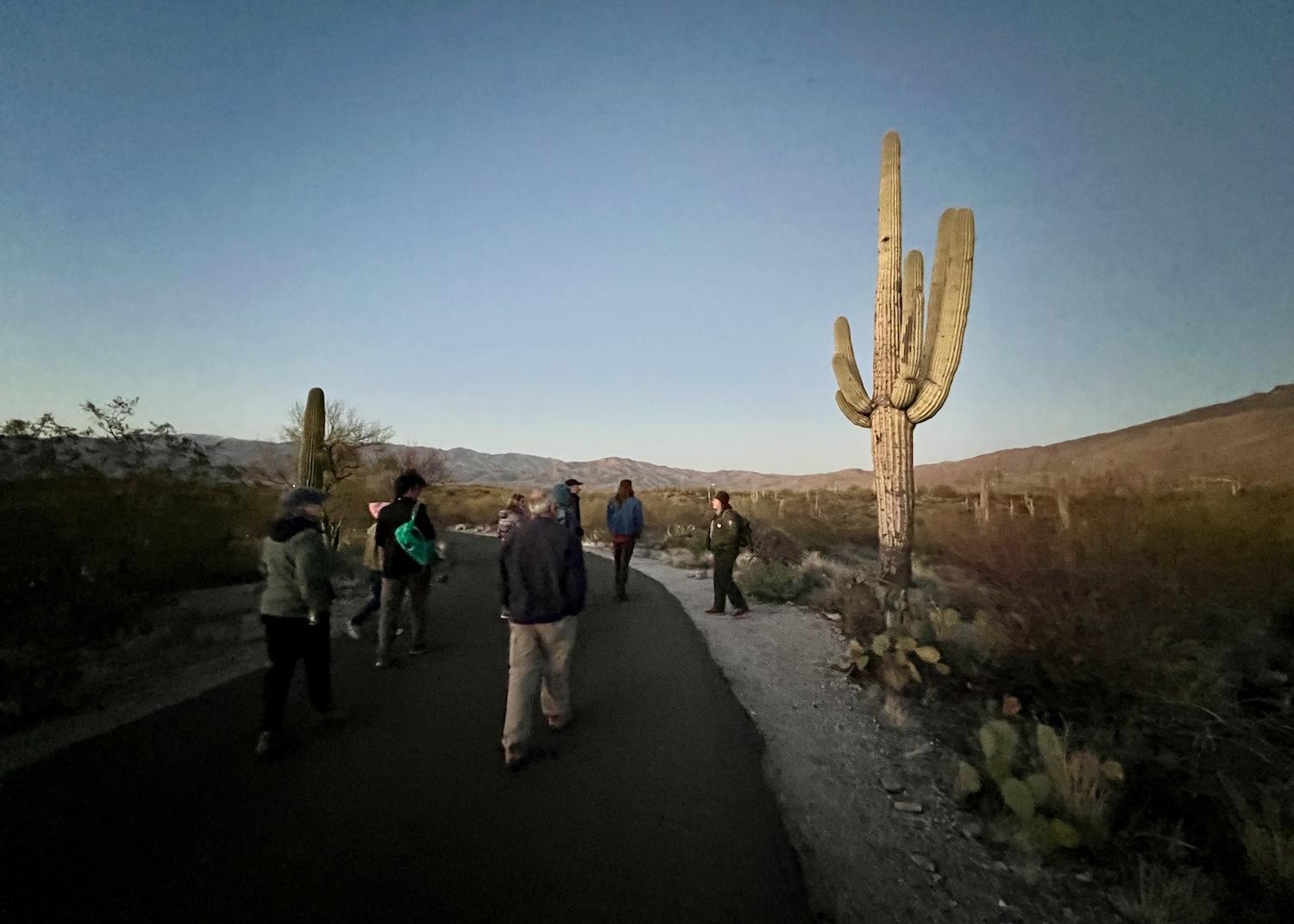
At dusk in February, Next Generation Ranger Malana Starr leads Saguaro National Park guests on a walk down Cactus Forest Drive/Jennifer Bain
Speaking of Tucson, it has been steadily expanding closer to the park’s boundaries. With that inevitably comes light pollution — human-made light that alters or disrupts natural light — that is easy to see at night as a glow that grows up from the horizon. Outdoor lighting can, in the words of DarkSky International, "disrupt wildlife, impact human health, waste money and energy, contribute to climate change and block our views of the universe."
Darkness tells people when to sleep, bats when to search for food and saguaros when to open their flowers to be pollinated. Some animals hunt at night when it’s easier to evade predators and cooler if they need to conserve water.
While the urban light issue won’t go away, Saguaro considers itself lucky to be within a region that preserves and celebrates dark night skies.
In 1972, Tucson and Pima County created outdoor lighting ordinances so that night lights wouldn’t interfere with astronomical research programs at places like Kitt Peak National Observatory, Mount Graham International Observatory, Fred Lawrence Whipple Observatory, and the Mt. Lemmon SkyCenter and Steward Observatory.
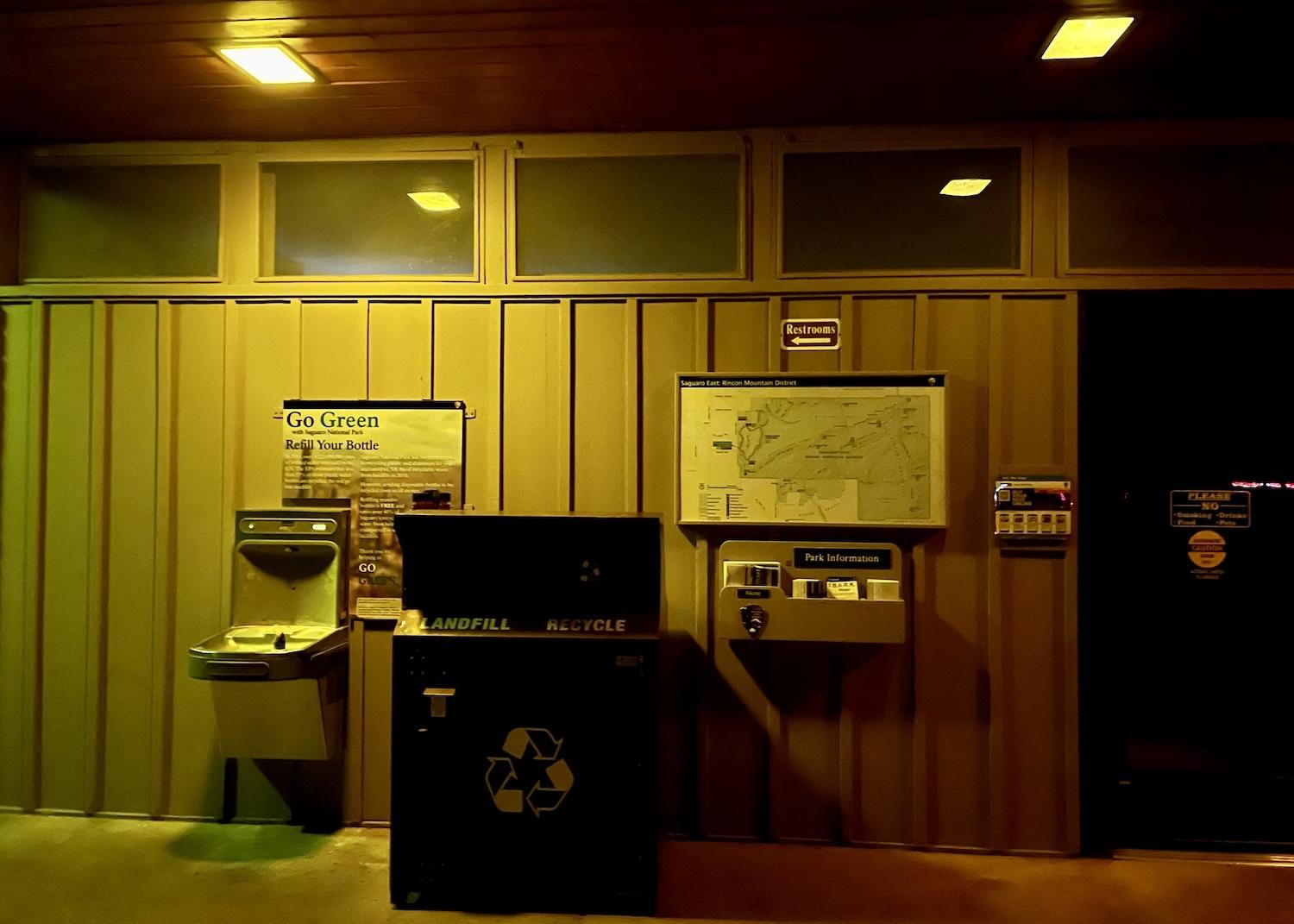
At night, the Rincon Mountain Visitor Center is closed but has useful, targeted, low level, controlled and warm-coloured lights by the washrooms/Jennifer Bain
Tucson is also the headquarters of DarkSky International, which preserves and protects the nighttime environment and our heritage of dark skies through environmentally responsible outdoor lighting. Its International Dark Sky Places Program encourages communities, parks and protected areas to voluntarily preserve and protect dark sites through effective lighting policies, environmentally responsible outdoor lighting and public education.
Saguaro is too close to the city to earn a dark sky designation, but the Urban Night Sky Place certification recognizes sites that are near, or surrounded by, large urban areas “and whose planning and design actively promote an authentic nighttime experience in the midst of significant artificial light at night.”
Park staff — with help from Friends of Saguaro National Park, Sky Island Alliance, Tucson Amateur Astronomy Association, University of Arizona and others — have spent years reducing human-made light to create a dark space for visitors and animals.
Saguaro’s lighting management plan and lighting retrofits follow DarkSky’s five principles for responsible outdoor lighting. “Light where you need it, when you need it, in the amount needed and no more,” is the light pollution authority's mantra. Light must be useful, targeted, low level, controlled and warm-colored.
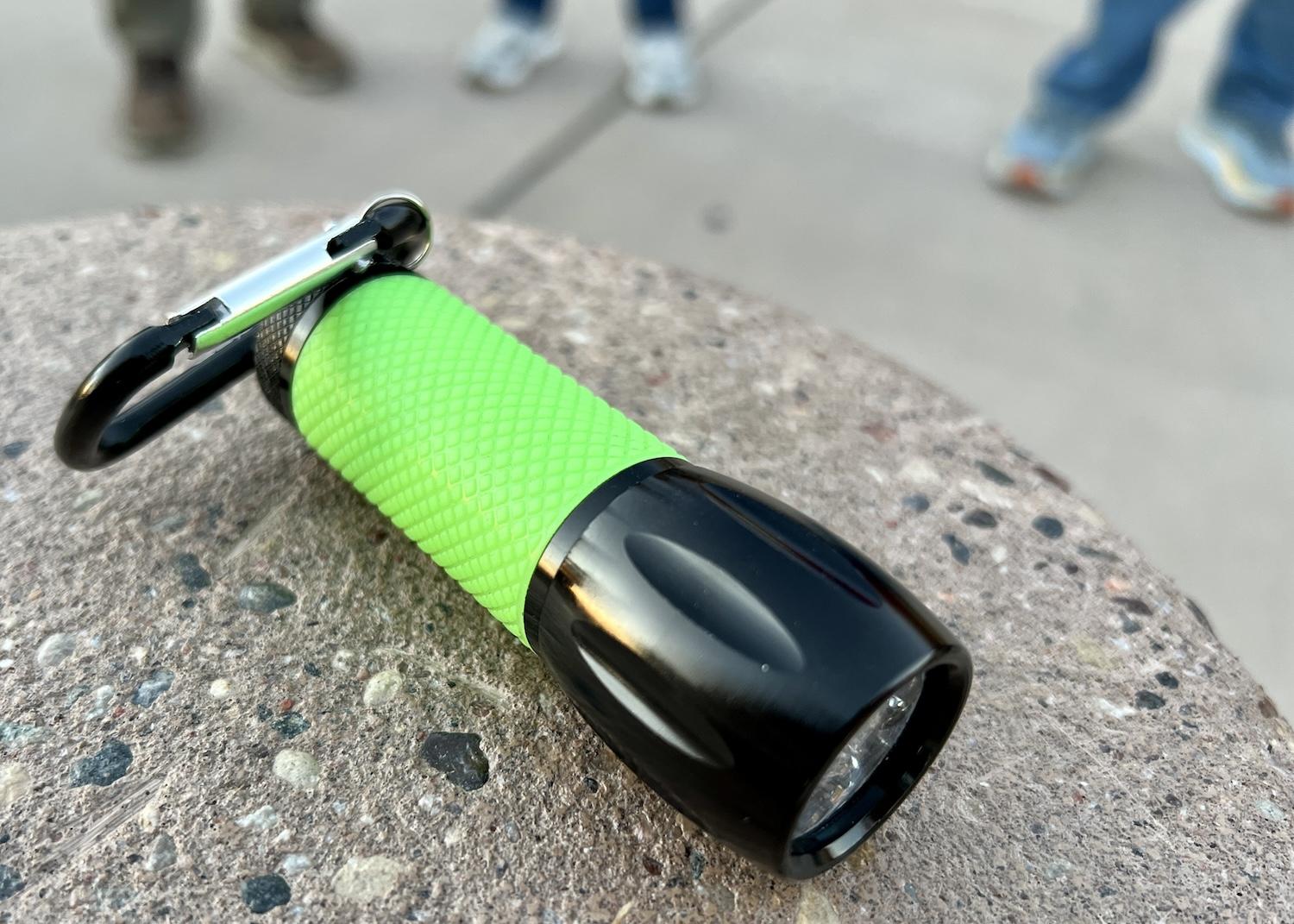
On night hikes in Saguaro National Park, rangers will loan you red light flashlights that protect your night vision and reduce your light signature/Jennifer Bain
Just 70 miles from Nogales in the Mexican state of Sonora, Tucson draws people for its gastronomy and astronomy.
On the gastronomy front, I ate what’s touted as America’s best Mexican food, starting with birria tacos at Taqueria Pico de Gallo and my first Sonoran hot dog at El Güero Canelo. Tucson is a UNESCO City of Gastronomy because the food here tells a story that dates back 4,000 years. On the astronomy front, it took time to wrap my head around the difference between stargazing with telescopes and simply enjoying the night sky with my naked eye.
From my first base at the Downtown Clifton, I quickly noticed the city streets seemed darker than I’m used to. When I moved to the Loews Ventana Canyon Resort on 100 acres of the Sonoran Desert, I watched the sunrise and sunset from an observation tower and stargazed from the tennis courts (something that’s offered three times a week with help from the Mt. Lemmon SkyCenter).
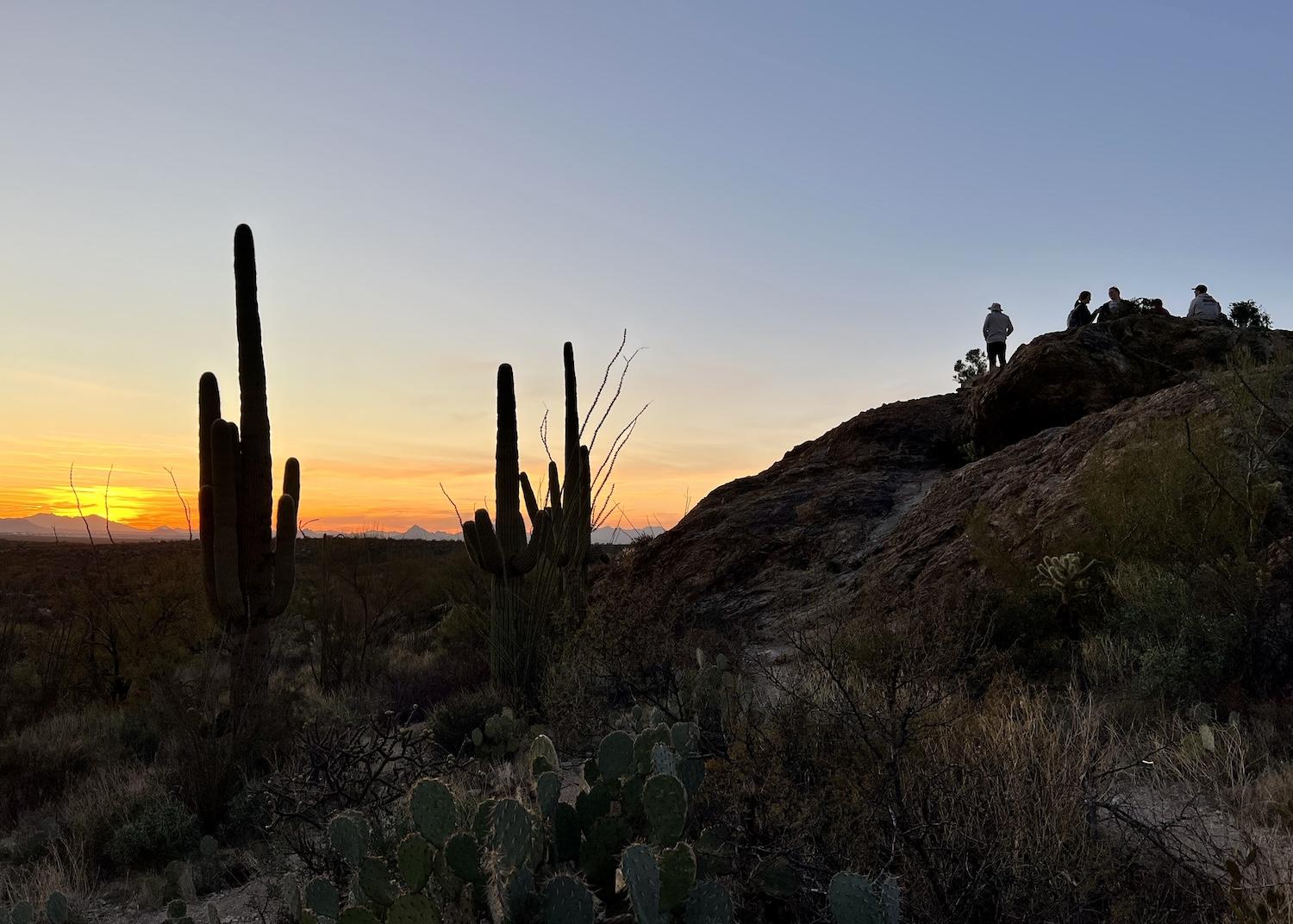
People gather on the Javelina Rocks in Saguaro National Park to watch the sun set over Tucson/Jennifer Bain
I quickly came to understand what Tucson Mayor Regina Romero meant when, to celebrate Saguaro National Park’s certification, she said “enjoying the beauty of the night sky is one of the ways Tucsonans engage with our natural beauty. Our beautiful sunsets followed by our impressive night skies connect us to our past and our heritage.”
Back home in Canada, I’ve struck out too many times to count at dark sky preserves and dark sky festivals due to clouds. But Tucson seems made for successful stargazing thanks to good weather, mountainous geography and sound stewardship.
“For being a big city, there are really dark skies here,” interpretive ranger Spencer Burke, who moved here from Mesa Verde National Park in Colorado, told me in the west district’s Red Hills Visitor Center. “The natural night sky is better for wildlife, better for people who live here and really important for the astronomical research that goes on here. We have a really good opportunity to interpret that for the public.”
Signage about the night sky certification is on tap for both visitor centers. Night walks, sunset/moonrise hikes and star parties happen regularly. Plans are underway for International Dark Sky Week in April.
“As visitors travel deeper into the park, larger expanses of darkness and changes in topography can obscure any indication of city light trespass, allowing for optimal dark sky viewing,” notes the park’s lengthy application for Urban Night Sky Place status. “It is common to be able to see an array of astronomical features year-round in Saguaro NP, including constellations, planets, and the Milky Way galaxy.”
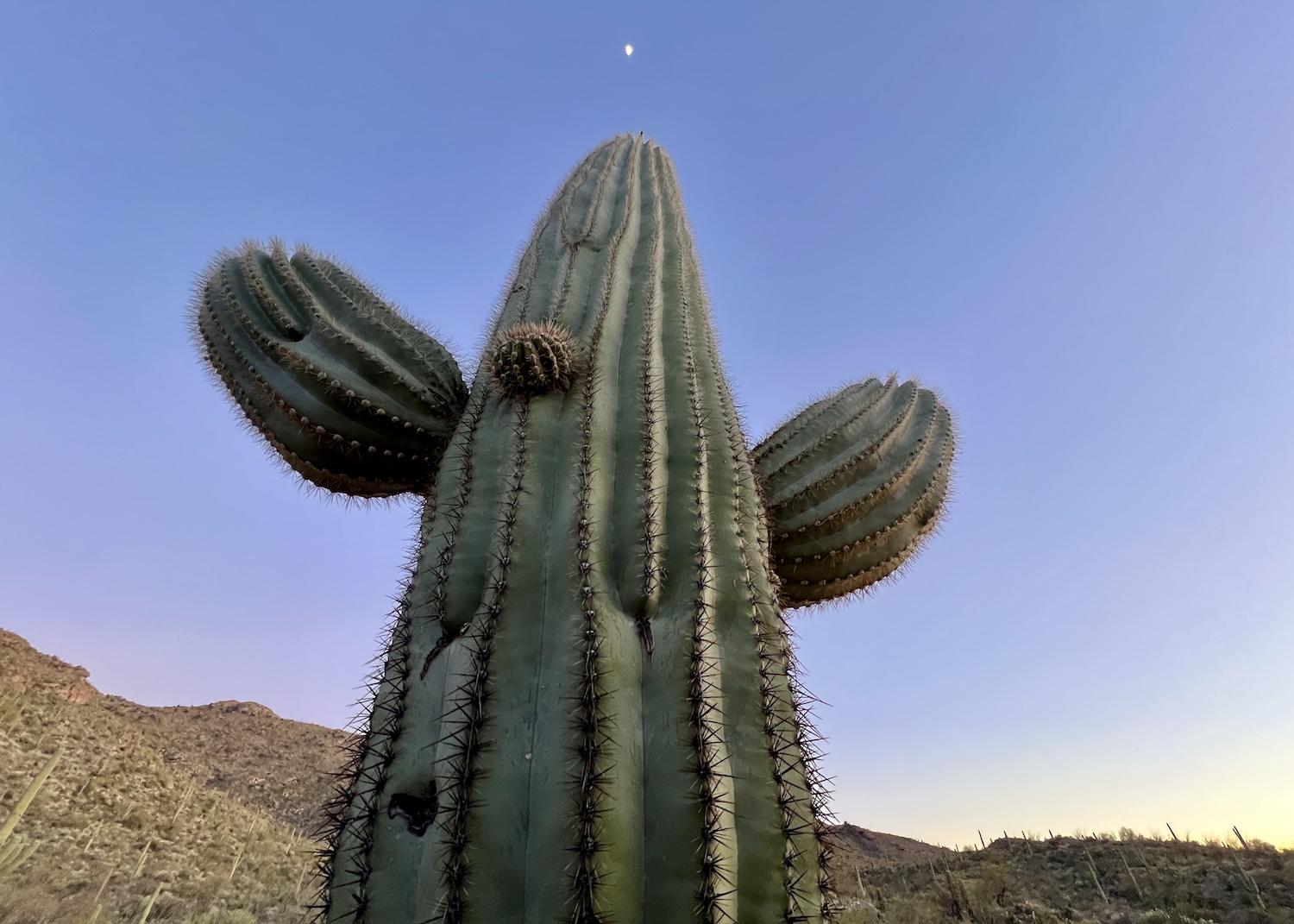
Minutes after sunset, the quarter moon shines in the sky above a saguaro in Saguaro National Park/Jennifer Bain
While the park gates close at 8 p.m., the west district's Desert Discovery Nature Trail is one always accessible spot that Burke suggests visiting to “listen to the sounds of the night.” And besides, he points out, when the sun sets at 6 at this time of year, you’ve got two hours of darkness to play with before the gates close.
I used that window of time to drive the west district’s five-mile Bajada Loop Drive, stopping at pullouts to marvel at the starry night and the way that saguaros look even more human at dusk than by day. In the east district, I did the same thing along the eight-mile Cactus Forest Drive after hiking that short stretch of it with Starr.
The ranger reminded me that people have always looked up to the stars, using them to navigate, share culture and history, and understand our place in the universe.
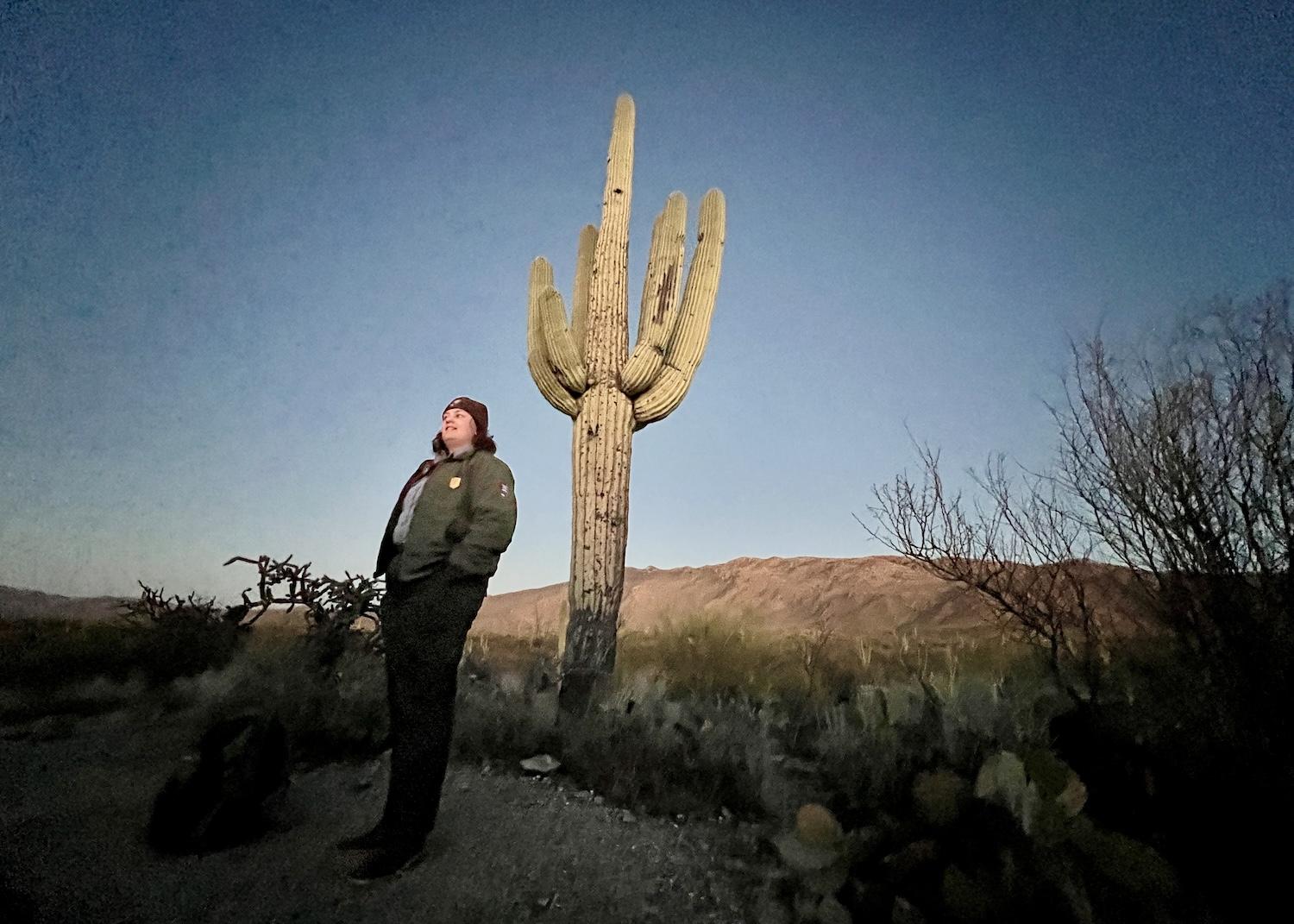
As night falls on Saguaro National Park, Next Generation Ranger Malana Starr talks about the cactus forest and the night sky/Jennifer Bain
On the ancestral lands of the Tohono O’odham people, Starr used a green laser pointer to trace the light pollution “dome” that hung over Tucson before easily showing us Jupiter, Orion’s Belt, the Big and Little Dipper, Cassiopeia, the star cluster Pleiades that Subaru uses for its logo, and Sirius, the brightest star in the night sky.
The ranger saved Canopus — new to me — for last and it was nice and low on the horizon. “That is a star that very few people around the world, especially here in the United States, are able to see. That’s pretty much as high as it’s going to get above the horizon and that’s a large reason that you can’t find it in other places. This is the perfect time of year to see it.”
On my last night in Tucson, I returned for an east district star party near the Rincon Mountain Visitor Center led by amateur astronomers like Doug Smith who pointed his 10-inch Dobsonian telescope at different targets, starting with Jupiter and some of its many moons.
“I’ve been doing this since I was five years old,” confided the man who wanted to be an astronomer but became an engineer instead. “Everywhere else that I have lived — Michigan, Connecticut, New Orelans and places like that — you couldn’t do amateur astronomy very well. So I was real happy when I got the job offer out here. I jumped at it.”
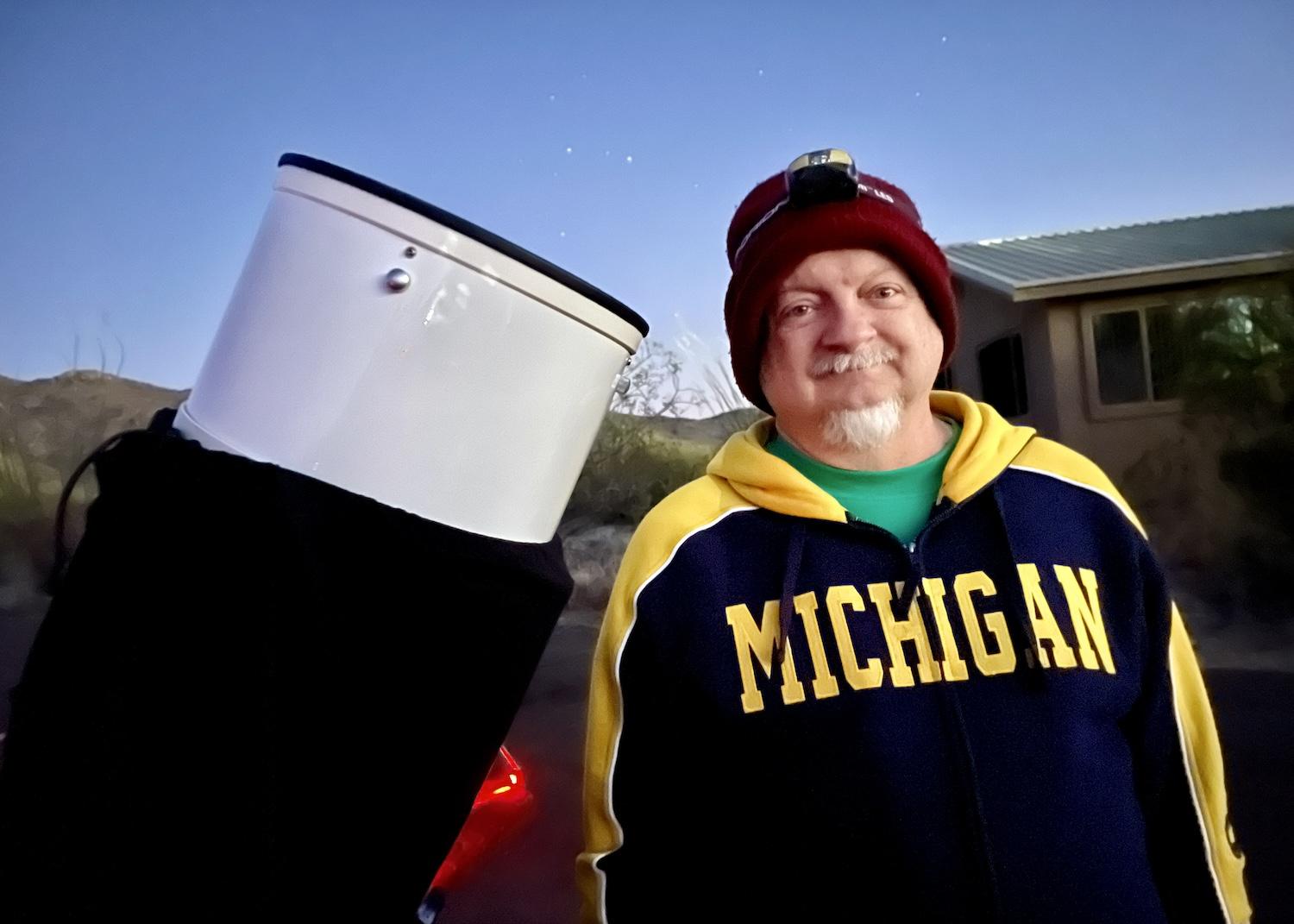
At a star party in Saguaro National Park's east district, amateur astronomer Doug Smith points his Dobsonian telescope at different targets in the sky/Jennifer Bain
While the star party was buzzing, quietly watching one last Tucson sunset just before the festivities was more my speed.
From the Javelina Picnic Area along Cactus Forest Drive, I climbed the Javelina Rocks. The small cluster of rocks was named for an aggressive collared peccary (often mistakenly called a pig) that travels in squadrons and is one of the animals that loves the shelter and shade here.
Alas, there were no javelina out at that moment, only people sprawled across the ancient granite. I watched the sun blaze orange over Tucson before disappearing. Then, to a symphony of Great-Horned Owls, Curve-billed Thrashers and Gila Woodpeckers, and under the bright light of the first quarter moon, I safely retraced my steps to my car.
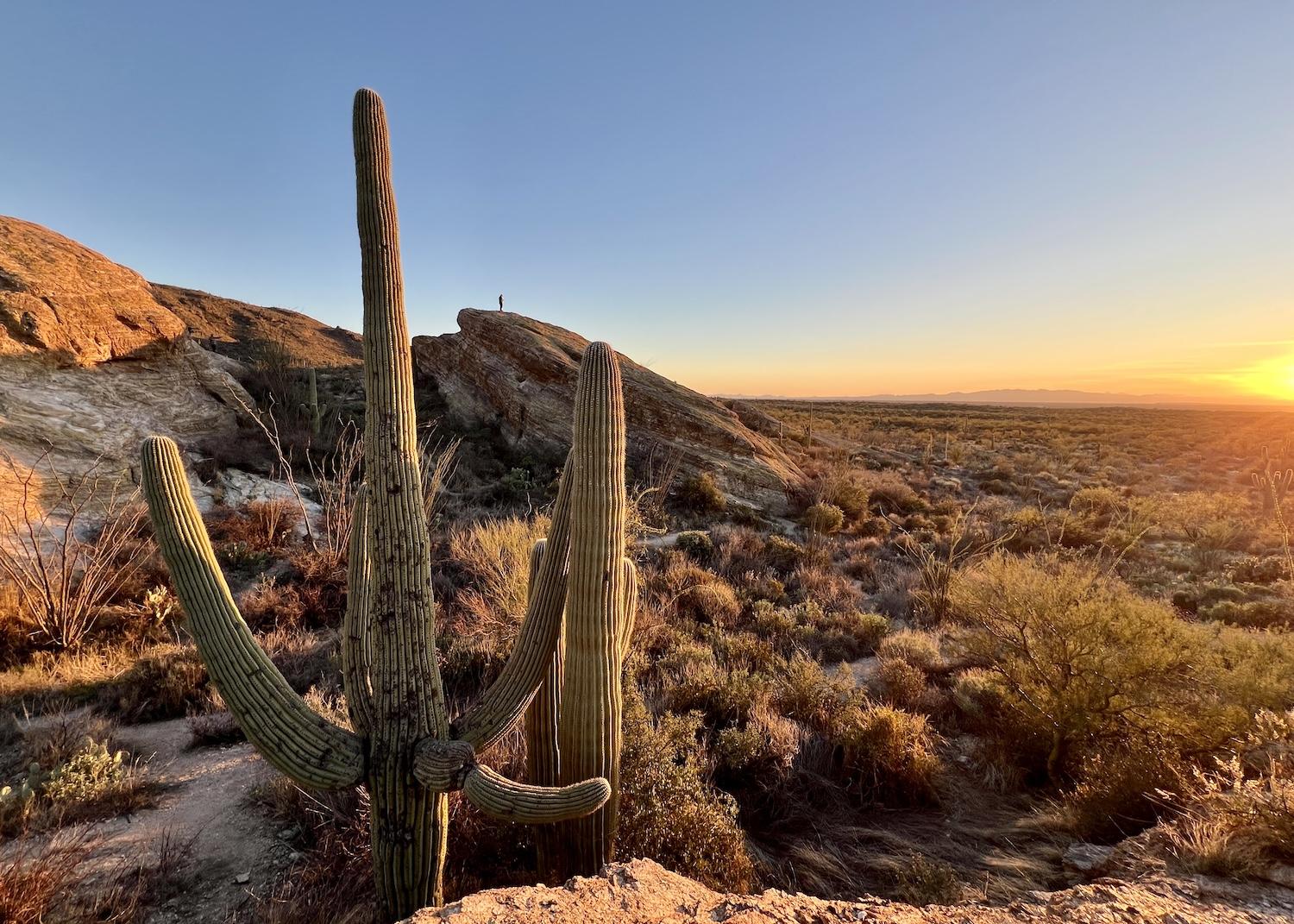
A man stands on the Javelina Rocks at sunset in Saguaro National Park/Jennifer Bain


